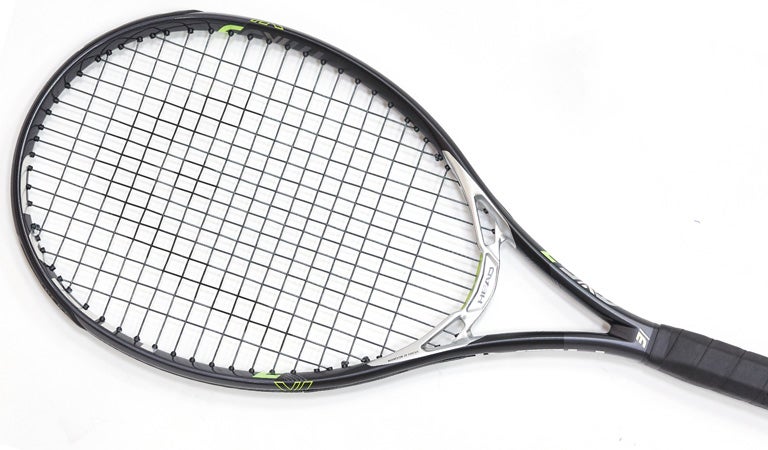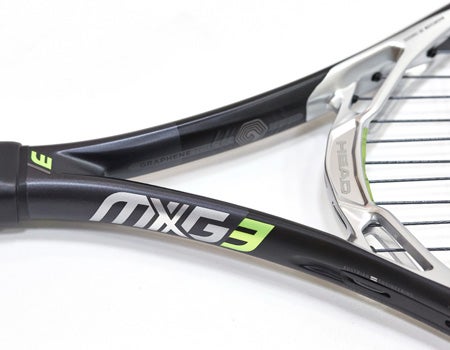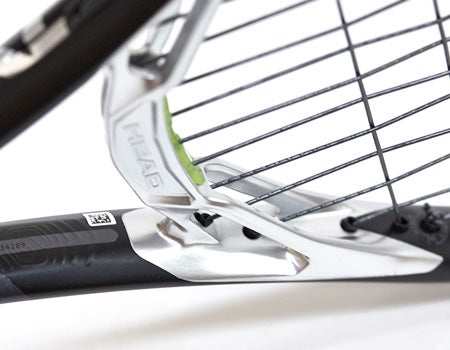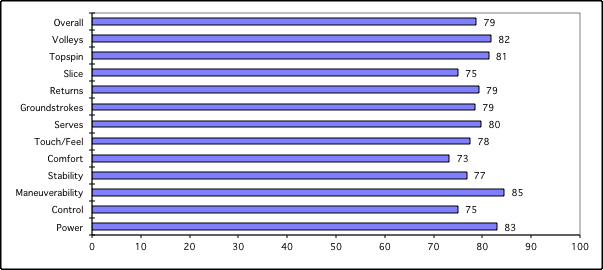Head MxG 3 Racquet Review

Summary
Lots of power, effortless handling and accessible spin were at our playtesters' disposal when they hit the courts with the Head MxG 3. The potential to generate depth was helped by the MxG 3's elongated main strings, which complemented the lively feel and versatile 16x18 string pattern. Our playtesters welcomed the user-friendly specs and discovered a generous sweetspot from the baseline. It was no surprise the maneuverable response adapted seamlessly to the serve and offered opportunities to use a combination of both spin and power to start off a point. Our playtesters enjoyed this racquet's ability to control net play and end the point with satisfying stability and prime ball pocketing. Our playtesters returns mirrored their groundstroke experience. They were able to block back first serves and step inside the baseline on weaker serves, but some of the playtesters found it difficult to balance the abundant power with adequate control. The Head MxG 3 definitely brings some added power to the crowded 'tweener racquet category.
Head MxG 3 Racquet Scores
| Power | 83 |
| Control | 75 |
| Maneuverability | 85 |
| Stability | 77 |
| Comfort | 73 |
| Touch/Feel | 78 |
| Serves | 80 |
| Groundstrokes | 79 |
| Returns | 79 |
| Slice | 75 |
| Topspin | 81 |
| Volleys | 82 |
| Overall | 79 |
Groundstrokes - Score: 79
The Head MxG 3 specs enticed Brittany from the start. She noted, "When I held this racquet in my hand I could feel the specs were right where I like them. When I was warming up I got into a groove right away, and the feel was very similar to what I'm used to. I was able to hit deep groundstrokes with pace when I was drilling, and I was able to get into a good rhythm. However, I lost a bit of control when it was time to play points. I was missing about 6 inches long on 95 percent of the points that I lost, which I believe was due to the launch angle of the 16x18 string pattern. I had to change the way I swung, add more spin and remain conservative while moving forward. I would say this racquet offered more power than control."
Finding the potential for massive amounts of power with the MxG 3, Jason tapped into this resource right away, saying, "Boy, was there some power to be had with this racquet. Power was definitely what stood out to me most. To control that power I really had to focus on accelerating through the ball to impart topspin to my shots. Even though I thought the side-to-side control was pretty good, I was having some trouble with depth control. Even when I added topspin I was still hitting shots long more than usual. I also would've liked a bit more mass in the hoop to help the racquet really drive through the ball when I hit with slice."
In an instance of fate, Mark picked up this racquet and was instantly drawn to its playability from the baseline. He explained, "My first encounter with Head's newest series of racquets was somewhat by chance. I was already in the middle of a hitting session, and a colleague left the MxG 3 on the court by accident. I picked it up and played with it because it reminded me of the older Prince Magnesium racquets that Pat Cash used to play with. I ended up playing with the MxG 3 for the rest of that session, and I concluded that it was a great baseline option for me. I definitely detected the extra mass of the MxG 3 (compared to the MxG 5), and I was able to direct the ball around the court effectively, keeping my opponents on their toes."
"This racquet required a full swing from the baseline," Hannah noted. "This can be a major benefit for me, especially for my forehand, because it keeps me accountable to what I don't always do -- which is really extending my swing and following through completely. Making contact in the sweetspot was extremely rewarding and resulted in easy depth, good spin and good control. During drills I appreciated the maneuverability, found really great rhythm and was hitting an effective ball. However, once I made contact slightly outside of the sweetspot my shots were difficult to gauge. When I couldn't take a full swing, whether because the ball was too close to my body or I was hitting on the run, I lost control and couldn't produce the shot I wanted with the same ease. I also ran into some trouble during point play. When I tried to create my own power and put the ball away I was more inconsistent than normal, and I found it difficult to be precise."

Volleys - Score: 82
With its low 11 oz strung weight and 320-ish swing weight, Mark was quick to put his trust in the Head MxG3. He praised the stability and performance at net, saying, "Even off-center contact produced some rewarding volleys, and if proper contact was made I was often able to end the point, or set myself up for an easy second shot."
Jason tended to agree. He expanded on what he believed to be some of the standout qualities of the MxG 3, saying, "I thought it was fairly stable for a racquet of its weight class. The elongated main strings helped contribute to the great ball pocketing. It felt really maneuverable at the net, which made it easy to get it into position."
Hannah sustained solid depth on her volleys, which put her in a good offensive position at net. She said, "I liked blocking back volleys because it was effortless and effective. The one complaint I had on volleys was an overall lack of directional control, mostly when I hit outside the sweetspot."
"I was actually surprised with how much I liked the MxG 3 on volleys," Brittany offered. "I was getting a consistent, solid response and could punch the ball back deep in the court. The racquet felt maneuverable, yet stable. I was aiming at big targets, like I do normally, and I had no issues ending points. I was also hitting a lot of swinging volleys with this racquet, and I had quite a bit of success moving forward and swinging through the ball."
Serves - Score: 80
Exploiting the Head MxG 3's versatility on her serve, Hannah mixed in flat serves, kick serves and slice serves. She said, "This fast swinging racquet felt good on my serves, and I found a good mixture of power and spin. I'm not sure if it was the elongated stringbed or something else, but there was a definite loss of power if I made contact somewhere in the lower two-thirds of the stringbed. This is the case with any racquet, but I noticed that it was do or die with the MxG 3. If I hit anywhere outside of the top third of the stringbed my serve was headed for the net, no matter what."
Similar to Hannah, Brittany took advantage of the adaptable characteristics of the MxG 3 to achieve good variety on her flat, slice and kick serves. She praised, "I didn't have any issues with control and was able to place my serves where I wanted. I found enough mass and racquet head speed to create a penetrating serve to start the point."
Jason had mixed feelings when it came to the serve, but he found a way to make it work in his favor. He said, "I felt like I wasn't serving with as much pace as I should've been considering how the MxG 3 performed on my groundstrokes and returns. On the plus side, I had really easy access to spin with the whippy response and open string pattern, so I was still hitting effective serves."
Mark also noted the effortless results he found when serving, "The combination of the Head MxG 3's 11.1 ounce strung weight and substantial 320 swingweight complemented my serve nicely. My consistency was right where I always want it to be with my serve. The open 16x18 string pattern of the Head MxG 3 made it easy for me to produce enough spin to keep the ball out of my opponent's strike zone."

Returns - Score: 79
The MxG 3 gave our team the confidence to start points off on the offensive with deep returns. Jason said, "I liked how I was hitting returns with the MxG 3. I didn't have to do much to get depth on my shots, and when I did have time to take a full swing I was able to really crack it. On my slice return the ball landed with plenty of depth and kept me in the point, even though I couldn't knife the slice."
Despite having to implement a few adjustments, Brittany was able to unlock the fast-swinging capabilities this racquet offered. She explained, "This racquet made it easy for me to get ready for any serve that came my way. Like my groundstrokes, I lost a little control when I was returning with the MxG 3, so I was aiming for bigger targets to get the point started. If I had to block a first serve back I kept it simple and let the racquet do the work."
Besides playing from the baseline with the Head MxG 3, Mark's other favorite part of this playtest was the serve return. He acknowledged the racquet's strengths, saying, "Any racquet that gives me the confidence to hit over the top of the serve return is going to be one that I love. My return showed some much needed improvement over the 25 hours or so that I played with the Head MxG 3."
Hannah also complimented the payoff she received on her returns, saying, "I was able to get into the same rhythm inside of the sweetspot that I found on my groundstrokes. I could block back shots and aggressively gain control even when I was faced with a difficult serve. However, the solid feel was missing for me on returns. The racquet always felt a little bit shaky, as if it was fluttering slightly."
Overall - Score: 79
| Technical Specifications | ||
|---|---|---|
| Length | 27 in | 69 cm |
| Head Size | 100 sq in | 645 sq cm |
| Weight | 11.1 oz | 315 gm |
| Balance Point | 13.18 in 33 cm | 3pts Head Light |
| Construction | 24mm / 26mm / 22mm / | |
| Composition | Graphite/Graphene Touch | |
| String Pattern | 16 Mains / 18 Crosses | |
| Babolat RDC Ratings | ||
|---|---|---|
| Score | Grade | |
| Flex Rating | 72 | Range: 0-100 |
| Swing Weight | 321 | Range: 200-400 |
| Mark's Scores | |||
|---|---|---|---|
| Power | 8.5 | Serves | 7.5 |
| Control | 8 | Groundstrokes | 8 |
| Maneuverability | 8 | Returns | 8 |
| Stability | 8 | Slice | 7.5 |
| Comfort | 7.5 | Topspin | 8.5 |
| Touch/Feel | 8 | Volleys | 8.5 |
| Overall | 8 | ||
| Hannah's Scores | |||
|---|---|---|---|
| Power | 7 | Serves | 8 |
| Control | 6.8 | Groundstrokes | 7.3 |
| Maneuverability | 8.8 | Returns | 7.7 |
| Stability | 7 | Slice | 7 |
| Comfort | 7 | Topspin | 7.5 |
| Touch/Feel | 7 | Volleys | 8 |
| Overall | 7.5 | ||
| Jason's Scores | |||
|---|---|---|---|
| Power | 8.7 | Serves | 8.1 |
| Control | 7.7 | Groundstrokes | 8.1 |
| Maneuverability | 9 | Returns | 8.2 |
| Stability | 7.9 | Slice | 7.7 |
| Comfort | 7 | Topspin | 8.5 |
| Touch/Feel | 8.2 | Volleys | 8 |
| Overall | 8.1 | ||
| Brittany's Scores | |||
|---|---|---|---|
| Power | 9 | Serves | 8.3 |
| Control | 7.5 | Groundstrokes | 8 |
| Maneuverability | 8 | Returns | 7.8 |
| Stability | 7.8 | Slice | 7.8 |
| Comfort | 7.8 | Topspin | 8 |
| Touch/Feel | 7.8 | Volleys | 8.2 |
| Overall | 7.9 | ||
Playtester Profiles
Brittany: Open level player with a semi-western forehand and a two-handed backhand. She currently plays with the Yonex EZONE DR 100.
Jason: 4.0 baseliner with a semi-western forehand and two-handed backhand. Currently using a Babolat Pure Strike 16x19 (Project One7).
Hannah: Open level player with a semi-western forehand and two-handed backhand. She currently plays with the Babolat Pure Strike 16x19 (Project One7).
Mark: 5.0 lefty all-court player with a one-handed backhand. He currently plays with the Babolat Pure Aero Tour.













Likes
Brittany- "There was easy power and maneuverability. I was a big fan of the MxG 3 at net and on serves."
Jason- "The MxG 3 offered easy access to power and spin. Nice ball pocketing."
Hannah- "Effective shots inside of sweetspot, good amounts of spin, easy depth and great maneuverability."
Mark- "Versatility and comfort are the two words that describe how I felt about the MxG 3. With a full bed of a polyester string this racquet was lively, yet comfortable on my arm and body. Aesthetically, I like its low-key color scheme. The 16x18 pattern helps further enhance the MxG 3's versatility, as it will work very well with a wide variety of string and tension configurations."
Dislikes
Brittany- "I wanted more control when I was playing points and hitting more aggressive shots."
Jason- "Pretty stiff feel. The power can be a bit uncontrollable without spin."
Hannah- "I lost most of the control and power when I hit outside of the sweetspot. It was difficult to be precise when I was creating my own power during points, and to end points."
Mark- "Like many of the other popular, low 11 oz racquets we feature, I would add a bit of weight to the MxG 3 to get a more stable feeling against the baseline bullies I play with here."
Comparing the racquet to others they've tried, our testers said:
Brittany- "There are a couple of racquets I have found to have similar characteristics to the MxG 3, including easy power and maneuverability and a little lack of control. These include the Dunlop Force 100 Tour, the Wilson Burn 100 Countervail and the Head Graphene XT Radical MP."
Jason- "The MxG 3 has the stiff, powerful and spin friendly response of the Babolat Aero Pro Team, but it's more stable and has better ball pocketing."
Hannah- "The MxG 3 was comparable to the Head Graphene Touch Speed MP. Neither racquet offers overwhelming amounts of power or spin, but they produced an effective ball inside the sweetspot. I would actually say that the MxG 3 offered slightly more power than the Touch Speed. However, the Touch Speed offered an extremely dampened feel. The feel of the MxG 3 was somewhere in between and was not a completely muted feel. The benefit of this was that I felt more connected to my shots with the MxG 3, but I also felt some unwanted shock."
Mark- "The MxG 3 is in a very competitive weight range, essentially the Hondas and Toyotas of the industry; you see them everywhere because they are so rewarding in an overall sense. The Babolat Pure Aero, AeroPro Drive, Pure Drive and Pure Strike 100, the Yonex EZONE DR 100 and VCORE SV 100, the Head Speed MP and Radical MP, the Wilson Blade 98S and Ultra 100, the Volkl V-Sense 8 (300), the Prince Textreme Warrior 100 and the Dunlop Precision 100 are all competing for the interest of the same type of player."